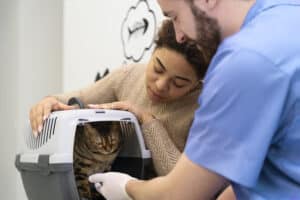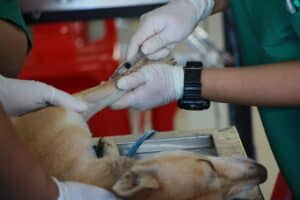Let’s talk about your relationship with your cat. Have you ever been petting your cat when she seems to suddenly turn on you, transforming from purring and sweet to evil and attacking? Cats can be mysterious creatures, and many owners of cats become frustrated with their seemingly erratic or aggressive behavior. But, the key to managing an aggressive cat is understanding cat aggression and knowing the signs that your cat could be ready for some alone time.
Types of Cat Aggression
Cat aggression often falls into one of the following categories:
- Territorial/resource aggression — Cats are territorial. When they perceive something as belonging to them, they may feel compelled to guard and protect it. Resources a cat might defend include scratching posts, food bowls, toys, and even people. A new visitor or pet in a cat’s home could also lead to aggressive behavior.
- Petting aggression — Some cats love to be petted. Others enjoy it, but only on their terms and for a duration with which they’re comfortable. Most cats who are about to reach their petting limit will exhibit at least one warning sign (see below) before losing their cool.
- Medically related aggression — Various medical conditions, including pain, hyperthyroidism, cognitive dysfunction, dermatological conditions, and more, can lead to aggression in cats. Cats on certain medications may also experience behavioral changes.
- Fearful/stressful aggression — Whether a cat is afraid of some unfamiliar noise or is feeling anxiety or stress because she just arrived home after being boarded during a vacation, cats that feel fearful or anxious are more likely to aggress.
- Predatory/play-related aggression — Most common among cats that were weaned from their mothers too early, cats experiencing predatory or play-related aggression didn’t have as much (or any) play time with their littermates, and, as a result, never learned bite inhibition.
Warning Signs of Cat Aggression
Watch for the following warning signs that your cat might be on the verge of attacking.
- Dilated pupils
- Flashing tail
- Hissing or growling
- Whiskers and/or ears held flat or pointing directly down or straight out
- Hair standing up on the back of the neck
- Backing into a corner and crouching into a small position or trying to look as large as possible
Your pet’s behavior significantly impacts every part of your day. A well-behaved pet will develop a beautiful, new relationship with your family. While a misbehaving pet will introduce unnecessary stress into your life. We believe the Human-Animal bond is one of the most beneficial and healthy relationships a person can form. And, just like the Human-Human bond, it all comes down to proper communication. We can help you set up healthy habits and communication protocols around your pet’s daily life, eating, exercise, and play time.
Far too many cats are relinquished to shelters (and often euthanized) because of behavior issues. If your cat is exhibiting aggressive behavior, call our office for help.








